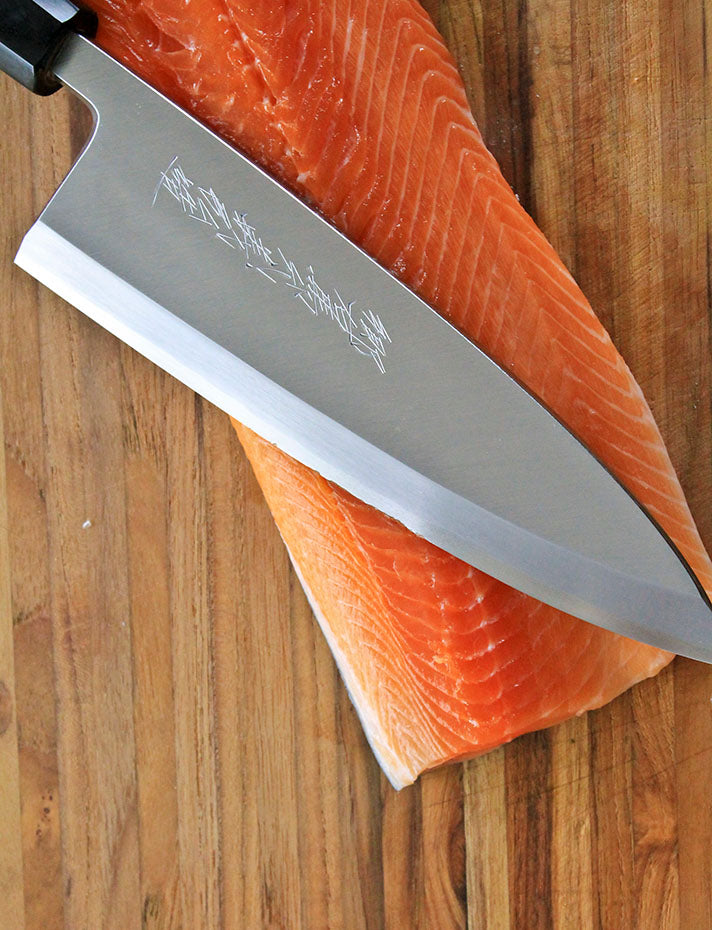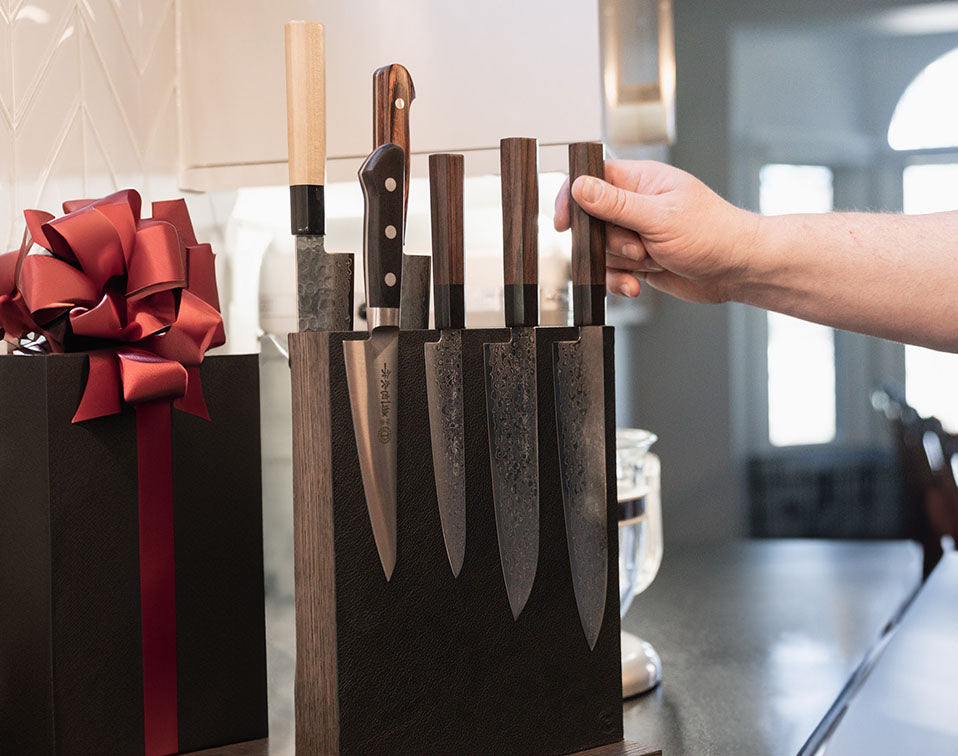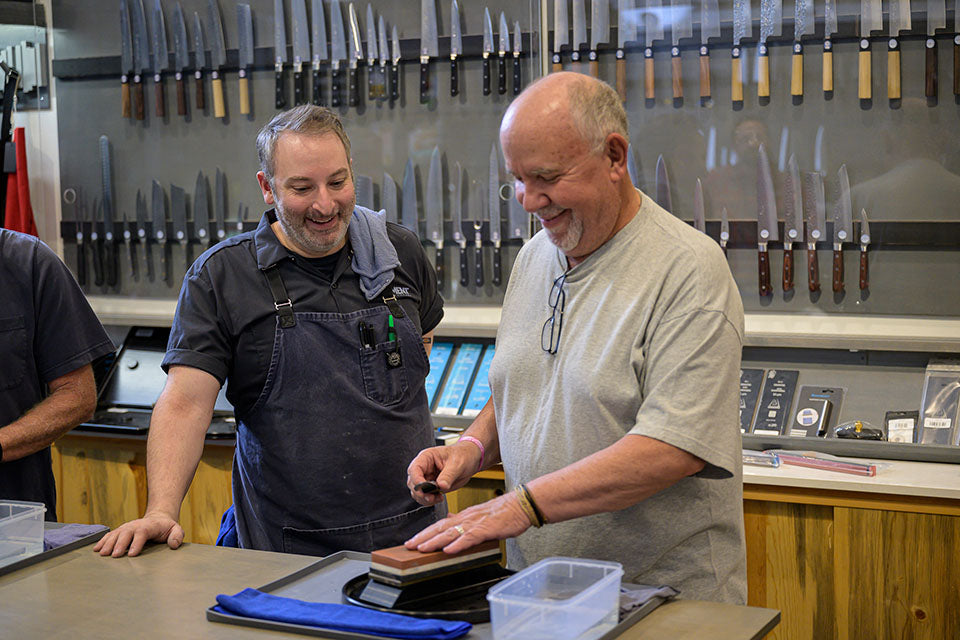
Shop Cutlery
Chef Curated Artisan Knives
Gifts To Cherish For Generations
Gift a slice of excellence to the culinary explorer or aspiring chef in your life with a top-tier knife or kitchen tool, expertly crafted to enhance their kitchen adventures.


All About Knives
Learning Center
About Element Knife Company
Learn more about our story and how Chef Elan found his way to curating the best cutlery in the world.

Knife Types
Double Bevel (Western Influence)

Gyuto (Chefs Knife)
A Gyuto has a classic Western chefs knife profile, but typically the blade thickness will be thinner. The two most common double-bevel types of Gyutos are Wa-Gyuto, referencing a Japanese style handle and Yo-Gyuto, referencing a western style handle. Additionally, there are single bevel Wa-Gyutos. "Gyuto" literally translates to "beef blade". This type of knife offers some of the most versatile cutting applications ranging from vegetable prep to meat and fish butchery. You will find that a Gyuto has a curved blade that allows for back and forth rocking, and quick and agile slicing.

Sujibiki
A Sujibiki is a slicing knife. It's long and narrow blade assists slicing through meat or vegetables smoothly and precisely. It has a profile similar to a Japanese Yanagi which helps for cutting sushi sashimi and rolls with ease.

Nakiri
Nakiris are typically a double bevel knife specifically designed to work with vegetables. The design is derived from the Japanese single bevel Usuba with a very thin spine, squared tip, wide and straight profile.

Honesuki
A Honesuki is traditionally a Japanese poultry boning knife. This knife has a profile which is thicker at the spine and wide at the heel, then contours to a narrow tip. This allows clean separation at joints and cartilage. This knife also works very well for cutting smaller fish like Aji, Kodai, and Kohada.

Petty
A petty knife is a basic utility knife slightly larger than a pairing knife. Typically petty and utility knives are used on a cutting board as opposed to a paring knife which does better when operated in your hand. They are great for intricate, delicate and light work.

Paring
Pairing knives are small and engineered to preform small tasks. Perfect for peeling and carving fruits and vegetables. They are typically designed to be used off the cutting board in your hand.

Santoku
A Santoku knife rivals the Gyuto in its functionality and multipurpose ability with its slight curve in the blade profile. Literally translated to three virtues, this knife performs at a high-level for meat fish and vegetables. It's profile exhibits a shorter and thinner blade which makes it user-friendly and versatile.

Kiritsuke Chefs Knife (K-Tip)
A kiritsuke Chefs knife is very versatile and modeled after the traditional Japanese single-bevel knife. The truncated tip drops the point, making it easy to perform detailed work with the tip. This multi-purpose knife will perform all kitchen tasks comfortably.
Single Bevel (Japanese)

Yanagi
A Yanagi is traditionally used for cutting sashimi. It's long slender blade and single bevel make for cutting sashimi, kiritsuge(slices of fish for nigiri) and rolls effortless. Chefs outside of sushi are finding that this style knife works exceedingly well at slicing roasted meats.

Yanagi-Kiritsuke
Kiritsuke means leaf in Japanese, this refers to the specialized shape of the tip of the Yanagi. This reverse Tonto is a delicate shape which allows for fine and precise work. It's long slender blade and single bevel make for cutting sashimi, kiritsuke(slices of fish for nigiri) and rolls effortless. Chefs outside of sushi are finding that this style knife works exceedingly well at slicing roasted meats.

Tako-biki
A Tako-biki was originally designed for cutting octopus(Tako) and originates out of the Kanto(Tokyo) region. It is a variation of a Yanagi with a blunted tip and a very straight edge. Best for cutting sashimi and kiritsuge(slices of fish for nigiri).

Saki-maru Tako-biki
This is a variation of the Tako-biki and in turn a variant of a Yanagi. Maru means round in Japanese, in reference to its rounded tip. It's long slender blade and single bevel make for cutting sashimi, kiritsuge(slices of fish for nigiri) and rolls effortless. Chefs outside of sushi are finding that this style knife works exceedingly well at slicing roasted meats.

Deba
The Deba is a thick and heavy knife with a short and broad profile. Designed for butchering fish and having the ability to cut through fish spines and heads. It is also great for heavy chopping, mincing, and making tartare.

Mioroshi-Deba
A Mioroshi-Deba is a hybrid of a Deba and Yanagi. Like a deba, exhibiting the characteristics needed to butcher a whole fish. This knife with a more narrow profile and slightly thinner spine, allows for finer detailed work.

Gyuto
A Gyuto has a classic Western chefs knife profile, but typically the blade thickness will be thinner. The two most common double bevel types of Gyutos are Wa-Gyuto, referencing a Japanese style handle and Yo-Gyuto, referencing a western style handle. Additionally, there are single bevel Wa-Gyutos. "Gyuto" literally translates to "beef blade". This type of knife offers some of the most versatile cutting applications ranging from vegetable prep to meat and fish butchery. You will find that a Gyuto has a curved blade that allows for back and forth rocking, and quick and agile slicing.

Kiritsuke
A Kiritsuke is a cross between a Yanagi and an Usuba. A Yanagi is typically used to slice raw fish for sushi and an Usuba is intended for vegetables. Most Kiritsuke designs retain a single bevel, although double bevel Kiritsukes are becoming more popular. It's unique profile and fine point allows for a general purpose approach to prep. It's slight curve in the blade profile allows for the ability to cut sushi and rolls with ease.

Usuba
Kanto and Kamagata styles. A Kanto Usuba has a blunted tip and originates from the Kanto(Tokyo) region. A Kamagata Usuba has a pointed tip and originates from the Kansai(Osaka)region of Japan. Usuba translates to "thin blade" and exhibits an extremely sharp edge. With its wide and straight blade profile, it is suited for the traditional Japanese push style of cutting as well as katsuramuki.

Soba-Kiri
This is a very specialized knife for making soba or udon noodles respectively. It's handle uniquely rests above the blade. It's straight blade profile and heft aid in cutting folded and flattened dough in a slight forward motion.
Muki-Mono or Kenmuki
Image coming soon!
This knife is a traditional Japanese vegetable knife. It's fine point and thin blade excel in small, intricate, and precise tasks.
Garasuki
Image coming soon!
A Garasuki is a single bevel Japanese boning knife. With a medium thick blade and narrowed tip this knife will handle tasks for deboning chickens, cutting through lobster shells and butchering small fish.
Fugubiki
Image coming soon!
Originally designed to cut fugu, this knife is a variant of a Yanagi. It is lighter weight with a thinner spine, and a more narrow blade profile.
- Choosing a selection results in a full page refresh.
Quick links
Learn
Blogs
Cut Deeper
We have even more to offer: follow us on TikTok, Facebook and Instagram to keep up with all of the latest news and to take advantage of discount codes and other offers. Thank you for visiting our site and we look forward to connecting with you!
Store Location:
1701 Platte St. Ste 171
Denver, CO 80202
!
































